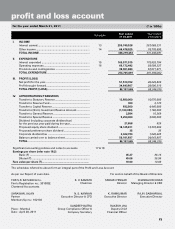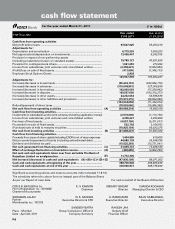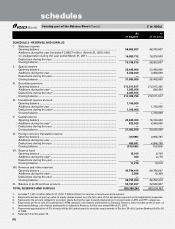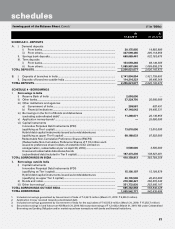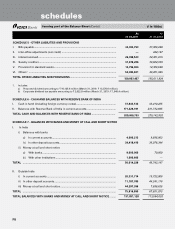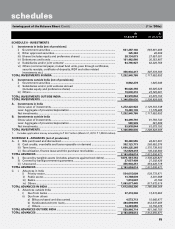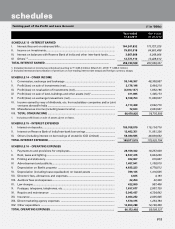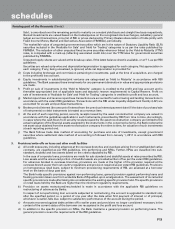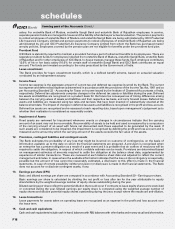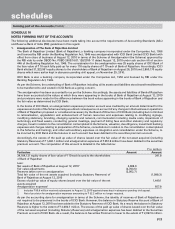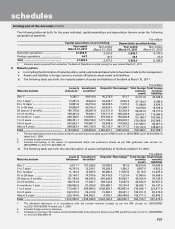ICICI Bank 2011 Annual Report Download - page 91
Download and view the complete annual report
Please find page 91 of the 2011 ICICI Bank annual report below. You can navigate through the pages in the report by either clicking on the pages listed below, or by using the keyword search tool below to find specific information within the annual report.
F13
Sale’, is amortised over the remaining period to maturity on constant yield basis and straight line basis respectively.
Quoted investments are valued based on the trades/quotes on the recognised stock exchanges, subsidiary general
ledger account transactions, price list of RBI or prices declared by Primary Dealers Association of India jointly with
Fixed Income Money Market and Derivatives Association (FIMMDA), periodically.
The market/fair value of unquoted government securities which are in the nature of Statutory Liquidity Ratio (SLR)
securities included in the ‘Available for Sale’ and ‘Held for Trading’ categories is as per the rates published by
FIMMDA. The valuation of other unquoted fixed income securities wherever linked to the Yield-to-Maturity (YTM)
rates, is computed with a mark-up (reflecting associated credit risk) over the YTM rates for government securities
published by FIMMDA.
Unquoted equity shares are valued at the break-up value, if the latest balance sheet is available, or at ` 1, as per RBI
guidelines.
Securities are valued scrip-wise and depreciation/appreciation is aggregated for each category. Net appreciation in
each category, if any, being unrealised, is ignored, while net depreciation is provided for.
d) Costs including brokerage and commission pertaining to investments, paid at the time of acquisition, are charged
to the profit and loss account.
e) Equity investments in subsidiaries/joint ventures are categorised as ‘Held to Maturity’ in accordance with RBI
guidelines. The Bank assesses these investments for any permanent diminution in value and appropriate provisions
are made.
f) Profit on sale of investments in the ‘Held to Maturity’ category is credited to the profit and loss account and is
thereafter appropriated (net of applicable taxes and statutory reserve requirements) to Capital Reserve. Profit on
sale of investments in ‘Available for Sale’ and ‘Held for Trading’ categories is credited to profit and loss account.
g) Market repurchase and reverse repurchase transactions are accounted for as borrowing and lending transactions in
accordance with the extant RBI guidelines. Transactions with the RBI under Liquidity Adjustment Facility (LAF) are
accounted for as sale and purchase transactions.
h) Broken period interest (the amount of interest from the previous interest payment date till the date of purchase/sale
of instruments) on debt instruments is treated as a revenue item.
i) At the end of each reporting period, security receipts issued by the asset reconstruction company are valued in
accordance with the guidelines applicable to such instruments, prescribed by RBI from time to time. Accordingly,
in cases where the cash flows from security receipts issued by the asset reconstruction company are limited to the
actual realisation of the financial assets assigned to the instruments in the concerned scheme, the Bank reckons the
net asset value obtained from the asset reconstruction company from time to time, for valuation of such investments
at each reporting period end.
j) The Bank follows trade date method of accounting for purchase and sale of investments, except government
securities where settlement date method of accounting is followed from January 1, 2011 in accordance with RBI
guidelines.
3. Provisions/write-offs on loans and other credit facilities
a) All credit exposures, including advances at the overseas branches and overdues arising from crystallised derivative
contracts, are classified as per RBI guidelines, into performing and NPAs. Further, NPAs are classified into sub-
standard, doubtful and loss assets based on the criteria stipulated by RBI.
In the case of corporate loans, provisions are made for sub-standard and doubtful assets at rates prescribed by RBI.
Loss assets and the unsecured portion of doubtful assets are provided/written off as per the extant RBI guidelines.
For advances booked in overseas branches, provisions are made at the higher of the provision required at the
overseas branch as per the host country regulations and provision required as per extant RBI guidelines. Provisions
on homogeneous retail loans, subject to minimum provisioning requirements of RBI, are assessed at a borrower
level on the basis of days past due.
The Bank holds specific provisions against non-performing loans, general provision against performing loans and
floating provision taken over from erstwhile Bank of Rajasthan upon amalgamation. The assessment of incremental
specific provisions is made after taking into consideration the existing specific provision held. The specific provisions
on retail loans held by the Bank are higher than the minimum regulatory requirements.
b) Provision on assets restructured/rescheduled is made in accordance with the applicable RBI guidelines on
restructuring of advances by Banks.
In respect of non-performing loan accounts subjected to restructuring, the account is upgraded to standard only
after the specified period i.e. a period of one year after the date when first payment of interest or of principal,
whichever is earlier, falls due, subject to satisfactory performance of the account during the period.
c) Amounts recovered against debts written off in earlier years and provisions no longer considered necessary in the
context of the current status of the borrower are recognised in the profit and loss account.
d) In addition to the specific provision on NPAs, the Bank maintains a general provision on performing loans. The
general provision covers the requirements of the RBI guidelines.
forming part of the Accounts (Contd.)
schedules


